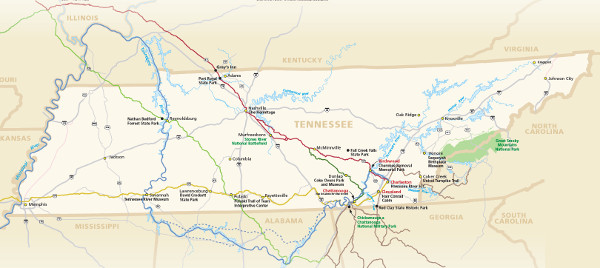

In 1838 the United States used military force to compel more than 16,000 Cherokee people to leave their homes in Alabama, Georgia, North Carolina, and Tennessee and move to Indian Territory, now known as the state of Oklahoma. The Cherokee refer to this forced emigration as "The Trail Where They Cried" - The Trail of Tears.
The Trail of Tears National Historic Trail was established by Congress in 1987 to commemorate the removal of the Cherokee and the routes they followed on the way to Indian Territory. The National Park Service administers the trail in partnership with other federal, state, and local agencies, nonprofit organizations, and private landowners. It covers 5,000 miles of land and water routes, and crosses nine states, including Tennessee.
The Trail of Tears National Historic Trail is a unique entry on our list of Native historical sites in Tennessee because it exists in all three geographical divisions of the state. The first section will be a two-part overview included in each list for East, Middle, and West Tennessee. The first part offers some background information on events that lead to the Cherokee removal, while the second part will give an overview of the routes followed by the Cherokee as they traveled the Trail of Tears to Indian Territory. We also plan to add more detailed pages on individual sites related to the Trail of Tears, as well as pages detailing the routes through every Tennessee county and major city.
Indian Removal was a series of tragic, shameful events in the history of the United States, and learning about it can be disturbing, but it's important to know about the past so we can better understand the present, and try to avoid mistakes we tend to make over and over again. It's also important to keep in mind that the Trail of Tears didn't destroy the Cherokee people. They overcame the tremendous hardship and injustice they endured during the nineteenth century and continue to thrive today, with a unique and powerful culture that continues to enrich the human race.

